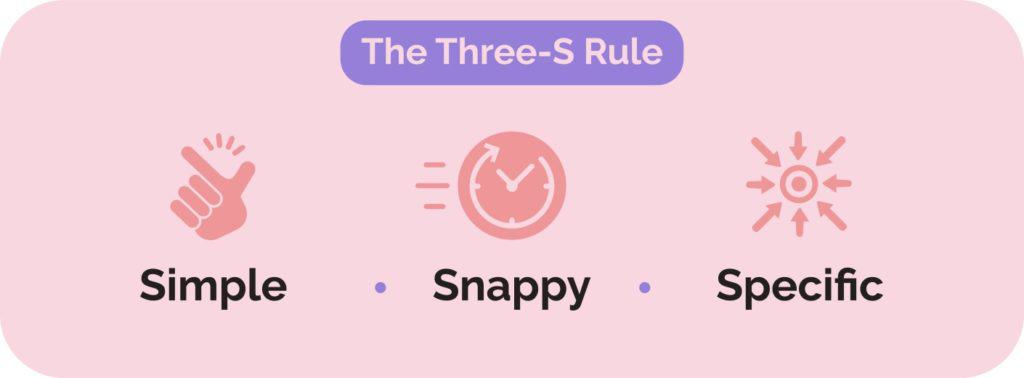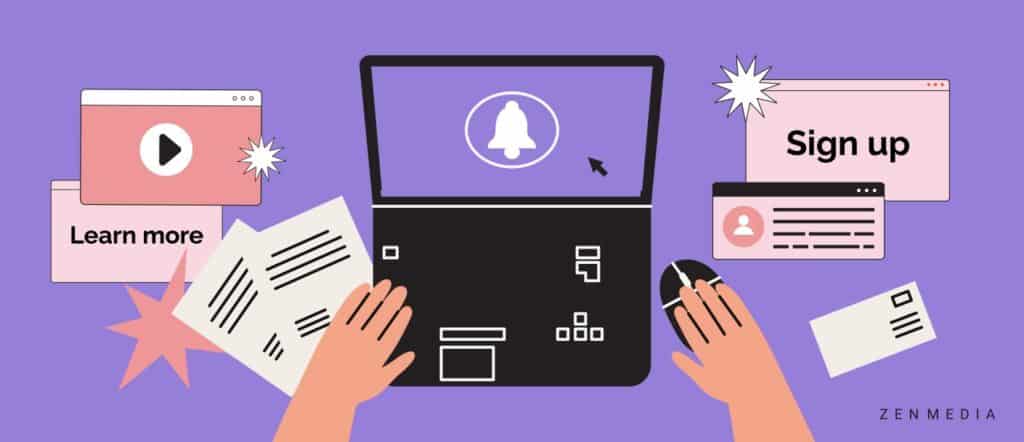Sign up. Learn more. Buy now.
You have likely come across all of these call-to-actions before. As social media algorithms change and paid ads flood our feeds, marketers need to write copy that sets their companies apart. It needs to be fun, engaging, and straightforward. But, most importantly, it needs to give prospective customers a reason to click.
The call-to-action (CTA) is the most important piece of the puzzle. AdRoll defines the CTA as “the part of a marketing message that attempts to persuade a person to perform the desired action.” In just a few words, a successful CTA tells users exactly what to do and directly links them to where they can do it. It should stand out from the rest of the post copy and streamline the buyer’s journey with just the click of a button.
The Importance of a Good Call to Action
Here are some quick statistics that highlight the power of a CTA:
- 90% of users who read your headline will also read your CTA copy
- Adding CTAs to your Facebook page can increase the click-through rate by 285%
- CTAs on a landing page of a company site can increase conversions by 80%
But to convert prospective customers into excited buyers, a CTA cannot be bland or overly wordy. So while “Sign up” and “Buy now” are direct, there are more creative ways for companies to call on their customers.
So how can marketers write the most effective CTAs? Luckily for you, our Zen Media team is sharing tips and tricks to writing call-to-actions that people actually click.
How to Write a Killer Call to Action
The Three-S Rule: Simple, Snappy, and Specific
When our team is writing CTAs for our clients, we stick to our Three-S Rule: simple, snappy, and specific. Let’s break it down.
Simple: Your company’s call-to-action should simply tell users what you want them to do. Don’t use jargon or complex language. Instead, be direct about the action you want them to take after viewing your post. Strong verbs like “Learn,” “Join,” and “Sign up” are effective for beginning your CTA.
Snappy: Keep your CTAs short and snappy—ideally between two to six syllables and six words or fewer. If you have more information that you want to share with your audience, try putting that in the body of your post. The snappier you can keep your CTA, the likelier you will retain prospects.
Specific: According to Hubspot, personalized call-to-actions perform 202% better than their generic counterparts. This stat shows that the more specific your CTA is, the better it will engage with users. Prospective clients are more likely to buy a product when it directly responds to their wants and needs.

So, instead of ending their pay-per-click ad with “Buy now,” an eyewear company could try writing a CTA like “Find your frames” or “Shop our glasses.”
The more specific your CTA can be, the better. Just make sure it remains simple and snappy at the same time!
Example: Vogue Magazine does a great job following our Three-S Rule on their Twitter profile. In less than 250 characters, the fashion magazine promoted their in-depth article with Lizzo. Beginning the post with some engaging context regarding the scope of the article, Vogue encouraged its followers to read the piece with a strong CTA: “Read the full profile here.”
This call-to-action is direct, contains simple word choices, and gives specific information about the article type. Combined with the copy before it, Vogue’s five-word, five-syllable CTA shares that there is much more to learn about the pop star by clicking the link.
Try second-person point-of-view.
A compelling CTA does not sound sales-pitchy. Instead, it should feel like a friend or colleague making a personal recommendation. Users want to feel like brands care. Research shows that
72% of consumers say they only engage with personalized messaging, 66% of consumers say that encountering non-personalized content would stop them from making a purchase, and 42% of consumers actually get annoyed when content isn’t personalized. That’s a lot of leads to leave on the table just because your CTA is generalized and vague.
Writing in the second-person point of view is a great way to add a personable touch to your CTA. Using “you” gives your copy a conversational tone while making your reader feel like the individual that they are.
Example: Hulu, the popular streaming service, speaks directly to its customers from the second-person point of view. The company writes a fun and personal CTA in an email newsletter that reads “Plan Your Movie Night.” The second-person encourages users to watch Hulu’s newest movie selections through relatable and conversational language.
Related read: 11 Email Marketing Strategies That Guarantee a 50% Click-to-Open Rate
Create a sense of urgency.
Creating a sense of urgency is a great way to turn prospective customers into buyers. There is no better time than the present for them to buy your product—and you want your CTA to emphasize this.
To increase conversions, try using time-related words and phrases. For example, instead of “Sign Up,” we suggest writing “Sign Up Now” or “Sign Up Today” as your CTA. To create even more urgency, you can tell users that it is their “Last Chance to Sign Up” for a special offer or give them an end date. FOMO (fear of missing out) is real, and a small dose of it can convince users to take action while they can.
Example: Clothing company Frank and Oak gives their followers a taste of FOMO through their Facebook posts. While promoting a sitewide sale, the company says, “Don’t miss out on our Flash Sale – Enjoy an extra 20% sitewide!” This short copy gives their followers the push they need to make that purchase they’ve been thinking about for months.
Write in your brand’s voice.
Give users a taste of your brand’s personality and values through the language you choose. Your brand has a unique voice, so use it. Consistency is essential with your word choice when writing CTAs.
For example, a fun makeup brand for Gen Z-ers will not write in the same tone as an insurance company targeting prospects for life insurance. Likewise, a rock musician promoting their next tour will not use the formal language that a lawyer would to schedule consultations with prospective clients.
Stay true to your brand by writing a CTA in its voice.
Example: Women’s clothing brand Nasty Gal does a great job promoting their latest collections through their fun and flirty tone. The company consistently writes copy that champions female empowerment by continually incorporating the hashtag #NastyGalsDoItBetter in their captions. In addition, their use of CTAs like “Shop Now” keeps things short and sweet. Here are a couple of examples:
“Auto reply: sorry we’re on vacation.
Denim staples to dominate from dawn to dark. Shop now.
Focus on one CTA at a time.
While many companies employ more than one CTA at a time in their digital marketing campaigns, we recommend focusing your efforts on just one at a time. If you ask your audience to do too much—or if your call-to-action is unclear—they will likely exit your post altogether.
Ellie Mirman, the VP of Marketing at Toast, found in her research that emails with a single call-to-action increased clicks by 371% and sales by 1617%. Focus your efforts on writing the best CTA that you can. You can always point users to take other actions in the future.
Need more help crafting engaging content and copy for your company? Do you want to collaborate on a campaign where your CTAs convert leads? Reach out. Let’s work together.




